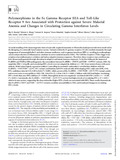Polymorphisms in the Fc Gamma Receptor IIIA and Toll-Like Receptor 9 Are Associated with Protection against Severe Malarial Anemia and Changes in Circulating Gamma Interferon Levels

View/
Date
2012-11-12Author
Munde, Elly O.
Okeyo, Winnie A.
Anyona, Samwel B.
Raballah, Evans
Konah, Stephen
Okumu, Wilson
Ogonda, Lilian
Vulule, John
Ouma, Collins
Metadata
Show full item recordAbstract
An understanding of the immunogenetic basis of naturally acquired immunity to Plasmodium falciparum infection would aid in the designing of a rationally based malaria vaccine. Variants within the Fc gamma receptors (FcγRs) mediate immunity through engagement of immunoglobulin G and other immune mediators, such as gamma interferon (IFN-γ), resulting in erythrophagocytosis and production of inflammatory cytokines in severe malarial anemia (SMA). The Toll-like receptors (TLRs) trigger transcription of proinflammatory cytokines and induce adaptive immune responses. Therefore, these receptors may condition malaria disease pathogenesis through alteration in adaptive and innate immune responses. To further delineate the impacts of FcγRIIIA and TLR9 in SMA pathogenesis, the associations between FcγRIIIA −176F/V and TLR9 −1237T/C variants, SMA (hemoglobin [Hb] < 6.0 g/dl), and circulating IFN-γ levels were investigated in children (n = 301) from western Kenya with acute malaria. Multivariate logistic regression analysis (controlling for potential confounders) revealed that children with the FcγRIIIA −176V/TLR9 −1237C (VC) variant combination had 64% reduced odds of developing SMA (odds ratio [OR], 0.36; 95% confidence interval [CI], 0.20 to 0.64; P = 0.001), while carriers of the FcγRIIIA −176V/TLR9 −1237T (VT) variant combination were twice as susceptible to SMA (OR, 2.04; 95% CI, 1.19 to 3.50; P = 0.009). Children with SMA had higher circulating IFN-γ levels than non-SMA children (P = 0.008). Hemoglobin levels were negatively correlated with IFN-γ levels (r = −0.207, P = 0.022). Consistently, the FcγRIIIA −176V/TLR9 −1237T (VT) carriers had higher levels of circulating IFN-γ (P = 0.011) relative to noncarriers, supporting the observation that higher IFN-γ levels are associated with SMA. These results demonstrate that FcγRIIIA-176F/V and TLR9 −1237T/C variants condition susceptibility to SMA and functional changes in circulating IFN-γ levels.
URI
https://doi.org/10.1128/IAI.00945-12https://journals.asm.org/doi/10.1128/iai.00945-12?permanently=true
http://r-library.mmust.ac.ke/123456789/1747
Collections
- Gold Collection [989]
